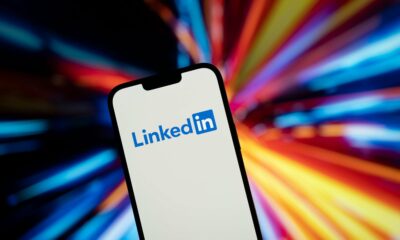NEWS
Twitter tests more attention-grabbing misinformation labels

Twitter is considering changes to the way it contextualizes misleading tweets that the company doesn’t believe are dangerous enough to be removed from the platform outright.
The company announced the test in a tweet Thursday with an image of the new misinformation labels. Within the limited test, those labels will appear with color-coded backgrounds now, making them much more visible in the feed while also giving users a way to quickly parse the information from visual cues. Some users will begin to see the change this week.
Tweets that Twitter deems “misleading” will get a red background with a short explanation and a notice that users can’t reply to, like or share the content. Yellow labels will appear on content that isn’t as actively misleading. In both cases, Twitter has made it more clear that you can click the labels to find verified information about the topic at hand (in this case, the pandemic).
“People who come across the new labels as a part of this limited test should expect a more communicative impact from the labels themselves both through copy, symbols and colors used to distill clear context about not only the label, but the information or content they are engaging with,” a Twitter spokesperson told TechCrunch.

Image Credits: Twitter
Twitter found that even tiny shifts in design could impact how people interacted with labeled tweets. In a test the company ran with a pink variation of the label, users clicked through to the authoritative information that Twitter provided more but they also quote-tweeted the content itself more, furthering its spread. Twitter says that it tested many variations on the written copy, colors and symbols that made their way into the new misinformation labels.
The changes come after a long public feedback period that convinced the company that misinformation labels needed to stand out better in a sea of tweets. Facebook’s own misinformation labels have also faced criticism for blending in too easily and failing to create much friction for potentially dangerous information on the platform.
Twitter first created content labels as a way to flag “manipulated media” — photos and videos altered to deliberately mislead people, like the doctored deepfake of Nancy Pelosi that went viral back in 2019. Last May, Twitter expanded its use of labels to address the wave of COVID-19 misinformation that swept over social media early in the pandemic.
A month ago, the company rolled out new labels specific to vaccine misinformation and introduced a strike-based system into its rules. The idea is for Twitter to build a toolkit it can use to respond in a proportional way to misinformation depending on the potential for real-world harm.
“… We know that even within the space of our policies, not all misleading claims are equally harmful,” a Twitter spokesperson said. “For example, telling someone to drink bleach in order to cure COVID is a more immediate and severe harm than sharing a viral image of a shark swimming on a flooded highway and claiming that’s footage from a hurricane. (That’s a real thing that happens every hurricane season.)”
Labels are just one of the content moderation options that Twitter developed over the course of the last couple of years, along with warnings that require a click-through and pop-up messages designed to subtly steer people away from impulsively sharing inflammatory tweets.
When Twitter decides not to remove content outright, it turns to an a la carte menu of potential content enforcement options:
- Apply a label and/or warning message to the Tweet
- Show a warning to people before they share or like the Tweet;
- Reduce the visibility of the Tweet on Twitter and/or prevent it from being recommended;
- Turn off likes, replies, and Retweets; and/or
- Provide a link to additional explanations or clarifications, such as in a curated landing page or relevant Twitter policies.
In most scenarios, the company will opt for all of the above.
“While there is no single answer to addressing the unique challenges presented by the range of types of misinformation, we believe investing in a multi-prong approach will allow us to be nimble and shift with the constantly changing dynamic of the public conversation,” the spokesperson said.
NEWS
OpenAI Introduces Fine-Tuning for GPT-4 and Enabling Customized AI Models

OpenAI has today announced the release of fine-tuning capabilities for its flagship GPT-4 large language model, marking a significant milestone in the AI landscape. This new functionality empowers developers to create tailored versions of GPT-4 to suit specialized use cases, enhancing the model’s utility across various industries.
Fine-tuning has long been a desired feature for developers who require more control over AI behavior, and with this update, OpenAI delivers on that demand. The ability to fine-tune GPT-4 allows businesses and developers to refine the model’s responses to better align with specific requirements, whether for customer service, content generation, technical support, or other unique applications.
Why Fine-Tuning Matters
GPT-4 is a very flexible model that can handle many different tasks. However, some businesses and developers need more specialized AI that matches their specific language, style, and needs. Fine-tuning helps with this by letting them adjust GPT-4 using custom data. For example, companies can train a fine-tuned model to keep a consistent brand tone or focus on industry-specific language.
Fine-tuning also offers improvements in areas like response accuracy and context comprehension. For use cases where nuanced understanding or specialized knowledge is crucial, this can be a game-changer. Models can be taught to better grasp intricate details, improving their effectiveness in sectors such as legal analysis, medical advice, or technical writing.
Key Features of GPT-4 Fine-Tuning
The fine-tuning process leverages OpenAI’s established tools, but now it is optimized for GPT-4’s advanced architecture. Notable features include:
- Enhanced Customization: Developers can precisely influence the model’s behavior and knowledge base.
- Consistency in Output: Fine-tuned models can be made to maintain consistent formatting, tone, or responses, essential for professional applications.
- Higher Efficiency: Compared to training models from scratch, fine-tuning GPT-4 allows organizations to deploy sophisticated AI with reduced time and computational cost.
Additionally, OpenAI has emphasized ease of use with this feature. The fine-tuning workflow is designed to be accessible even to teams with limited AI experience, reducing barriers to customization. For more advanced users, OpenAI provides granular control options to achieve highly specialized outputs.
Implications for the Future
The launch of fine-tuning capabilities for GPT-4 signals a broader shift toward more user-centric AI development. As businesses increasingly adopt AI, the demand for models that can cater to specific business needs, without compromising on performance, will continue to grow. OpenAI’s move positions GPT-4 as a flexible and adaptable tool that can be refined to deliver optimal value in any given scenario.
By offering fine-tuning, OpenAI not only enhances GPT-4’s appeal but also reinforces the model’s role as a leading AI solution across diverse sectors. From startups seeking to automate niche tasks to large enterprises looking to scale intelligent systems, GPT-4’s fine-tuning capability provides a powerful resource for driving innovation.
OpenAI announced that fine-tuning GPT-4o will cost $25 for every million tokens used during training. After the model is set up, it will cost $3.75 per million input tokens and $15 per million output tokens. To help developers get started, OpenAI is offering 1 million free training tokens per day for GPT-4o and 2 million free tokens per day for GPT-4o mini until September 23. This makes it easier for developers to try out the fine-tuning service.
As AI continues to evolve, OpenAI’s focus on customization and adaptability with GPT-4 represents a critical step in making advanced AI accessible, scalable, and more aligned with real-world applications. This new capability is expected to accelerate the adoption of AI across industries, creating a new wave of AI-driven solutions tailored to specific challenges and opportunities.
This Week in Search News: Simple and Easy-to-Read Update

Here’s what happened in the world of Google and search engines this week:
1. Google’s June 2024 Spam Update
Google finished rolling out its June 2024 spam update over a period of seven days. This update aims to reduce spammy content in search results.
2. Changes to Google Search Interface
Google has removed the continuous scroll feature for search results. Instead, it’s back to the old system of pages.
3. New Features and Tests
- Link Cards: Google is testing link cards at the top of AI-generated overviews.
- Health Overviews: There are more AI-generated health overviews showing up in search results.
- Local Panels: Google is testing AI overviews in local information panels.
4. Search Rankings and Quality
- Improving Rankings: Google said it can improve its search ranking system but will only do so on a large scale.
- Measuring Quality: Google’s Elizabeth Tucker shared how they measure search quality.
5. Advice for Content Creators
- Brand Names in Reviews: Google advises not to avoid mentioning brand names in review content.
- Fixing 404 Pages: Google explained when it’s important to fix 404 error pages.
6. New Search Features in Google Chrome
Google Chrome for mobile devices has added several new search features to enhance user experience.
7. New Tests and Features in Google Search
- Credit Card Widget: Google is testing a new widget for credit card information in search results.
- Sliding Search Results: When making a new search query, the results might slide to the right.
8. Bing’s New Feature
Bing is now using AI to write “People Also Ask” questions in search results.
9. Local Search Ranking Factors
Menu items and popular times might be factors that influence local search rankings on Google.
10. Google Ads Updates
- Query Matching and Brand Controls: Google Ads updated its query matching and brand controls, and advertisers are happy with these changes.
- Lead Credits: Google will automate lead credits for Local Service Ads. Google says this is a good change, but some advertisers are worried.
- tROAS Insights Box: Google Ads is testing a new insights box for tROAS (Target Return on Ad Spend) in Performance Max and Standard Shopping campaigns.
- WordPress Tag Code: There is a new conversion code for Google Ads on WordPress sites.
These updates highlight how Google and other search engines are continuously evolving to improve user experience and provide better advertising tools.
Facebook Faces Yet Another Outage: Platform Encounters Technical Issues Again

Uppdated: It seems that today’s issues with Facebook haven’t affected as many users as the last time. A smaller group of people appears to be impacted this time around, which is a relief compared to the larger incident before. Nevertheless, it’s still frustrating for those affected, and hopefully, the issues will be resolved soon by the Facebook team.
Facebook had another problem today (March 20, 2024). According to Downdetector, a website that shows when other websites are not working, many people had trouble using Facebook.
This isn’t the first time Facebook has had issues. Just a little while ago, there was another problem that stopped people from using the site. Today, when people tried to use Facebook, it didn’t work like it should. People couldn’t see their friends’ posts, and sometimes the website wouldn’t even load.
Downdetector, which watches out for problems on websites, showed that lots of people were having trouble with Facebook. People from all over the world said they couldn’t use the site, and they were not happy about it.
When websites like Facebook have problems, it affects a lot of people. It’s not just about not being able to see posts or chat with friends. It can also impact businesses that use Facebook to reach customers.
Since Facebook owns Messenger and Instagram, the problems with Facebook also meant that people had trouble using these apps. It made the situation even more frustrating for many users, who rely on these apps to stay connected with others.
During this recent problem, one thing is obvious: the internet is always changing, and even big websites like Facebook can have problems. While people wait for Facebook to fix the issue, it shows us how easily things online can go wrong. It’s a good reminder that we should have backup plans for staying connected online, just in case something like this happens again.















